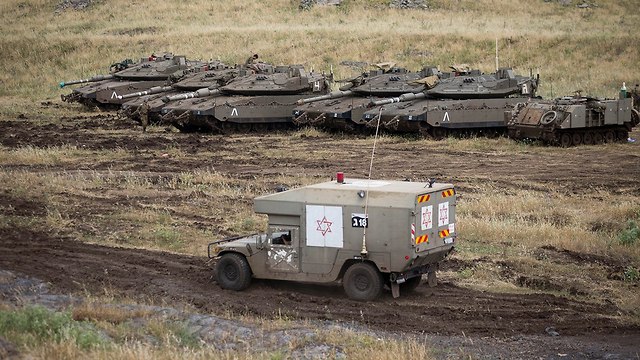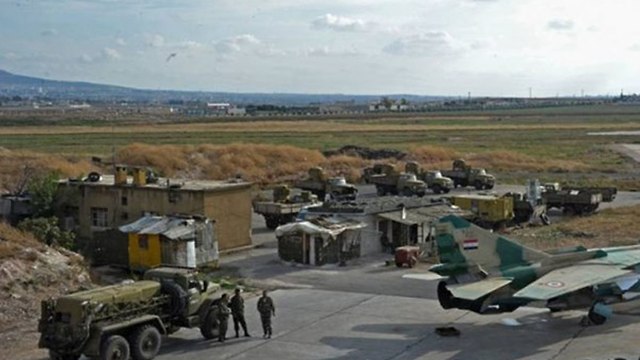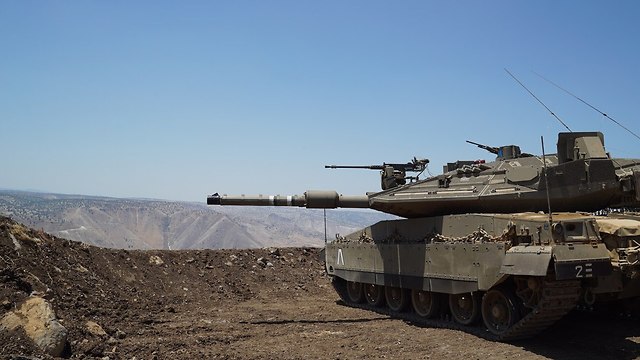Analysis: The Israelis have given a clear ultimatum to Syria: a military force entering the buffer zone in Quneitra will be destroyed. Russia has made a commitment to Israel to keep Iranian forces 100 km from the border, while the US is holding Israel on a loose leash as the IDF prepares to pounce on Syria’s army the moment the Kremlin allows it to go too far.
Israel has given the Syrians a clear ultimatum regarding the continued takeover of the Syrian Golan by President Bashar Assad’s regime. Every military force that breaks the 1974 Disengagement Agreement and enters the demilitarized “buffer zone” will be destroyed.
This Israeli threat, which was delivered to the Syrians more than once, will be put to the first real test in the upcoming days. The Syrian army—in accordance with the understandings reached between them and the Russian-mediated rebel forces—will enter Quneitra, with Israel’s knowledge, in order to restore its sovereignty in the area.
According to the Separation of Forces Agreement, Quneitra, which is located three kilometers from the border, is a buffer zone that prohibits the presence of military personnel and weapons.

Will the Syrian army abide by the rules and refrain from entering Quneitra with armed forces? The public reinforcement of the IDF forces in the Golan Heights last week was meant to remind the Syrians of what will happen if they violate the agreement and enter the buffer zone.
Mission statement
The US finds the Israeli ultimatum to be acceptable. This was one of the issues raised in the meeting between the IDF’s Chief of Staff Gadi Eisenkot, with his American counterpart, General Joseph Dunford, in Washington last week. In the past three weeks, while the Syrian army was fighting in the southern Golan Heights, the Syrians abided by the rules and refrained from entering Quneitra.
The Syrians also showed utmost care in allowing the Iranian axis forces from joining in the fighting,
It was made clear to them that even if a few Iranian advisors were deployed in the fighting zone, Israel would consider this as grounds for opening fire, since these advisors might remain in Syria permanently, let alone pro-Iranian militias and Hezbollah terror forces.
If it was indeed Israel who was behinds this week’s explosion of an ammunitions storage belonging to pro-Iranian militias in the southern Golan Heights, it was a declaration of intent which demonstrated the gravity of the ultimatum.

Moreover, the Syrians understand that Russia will not prevent Israel from exercising its right to uphold the disengagement agreements using force. In their talks with Prime Minister Netanyahu, Defense Minister Lieberman and Eisenkot, the Russians do not explicitly give Israel a green light, but they do so in practice at the battlefield. Therefore, both the US and Russia will not prevent Israel from using force deep inside Syria, within 25 kilometers of the Israeli border.
This is a strip that includes the buffer zone, which ranges between a few meters to 13 kilometers in breadth in the northern Golan Heights, and three areas where restrictions on the stationing of forces allowed varies.
It is much more complicated for the Russians than it is for the Americans, for it is the Russians who rebuilt the Syrian ground forces and formulated the Syrian army operational plans. Informally, the Russians even command these operations. It is no wonder these generals are running over to Moscow to complain about Israel.
But it is in Russia where they come across the blank faces of Putin and Defense Minister Sergei Shoygu. The restrictions imposed by Moscow on its commanders in Syria are a part of a cynical politician’s game played at the expense of the soldiers. Since entering Syria, the Russian air force alone has lost 19 aircraft and 60 military personnel, most of them air crew members, and dozens of Russian military personnel and volunteers in ground warfare.
The Russian army fights, pays in human lives, but, when it comes to Israel, the generals feel that their hands are tied.
This coming Wednesday, Netanyahu will arrive in Moscow again. According to Russian sources, the prime minister will try to influence the Kremlin’s positions regarding the Syrian issue, ahead of the Putin-Trump summit on July 16.
The Americans promised Israel that they would demand the withdrawal of all Iranian forces from Syria at the summit. The Russians do not accept this demand. They talk about the continued presence of Iran in Syria, but they promised Lieberman and Eisenkot that they will keep the Iranians a hundred kilometers away from the Israeli border.So far, this commitment has only partially been realized.
It is unclear how long Trump and Putin will spend discussing the Syrian issue when other global crises keep piling up on their desks.
For months now, Israel has been running around between the White House and the Kremlin in an attempt to devise a plan that will help them reach an agreement regarding the Iranian forces in Syria. It is clear to Israel that the Russian position on the matter is a direct result of the clash between Russia and the US regarding other international matters such as North Korea, Europe, China, Ukraine, etc. The Iranians in Syria are mere bargaining chips.
According to the Russian news agency RIA, Netanyahu and Putin will also discuss the planned Syrian attack on the Quneitra district, where Russia will have to restrain its client state in a much more resolute manner, since air and artillery attacks in this region will challenge the Israeli ultimatum much more than it would do in Daraa.
Not to mention a situation in which the Syrian army tries to conduct a ground maneuver near the buffer zone. It is clear to the Syrians that any “navigational errors” will be met with Israeli fire, but what will Israel do if the Syrian army fires artillery at refugee centers situated only a few kilometers away from the border?
A game played between the Russians and the Americans
In the meantime, the Syrian attack in the southern Golan Heights, 30 kilometers away from the Israeli border, was closest to the buffer zone when Syrian artillery hit a town 12 kilometers away from the border. The Syrian forces moved towards the capital of the Daraa district in two axes, north and east, in order to encircle it.
A serious conflict with the rebels in Daraa has not yet begun. It will take place in the province’s five largest cities and towns. The occupation of the Daraa district could last for weeks, and there is always a chance that fire will spill over into Israel and inflame the relations between the IDF and the Syrian army.

In addition, the Syrian 9th Division stationed in Al-Sanamayn in the southern part of the country which is responsible for the Syrian section of the Golan Heights, is ready to take Quneitra either through and agreement or through war. It is perfectly reasonable to assume that the Russian mentors will escort the division to ensure that it does become embroiled in a conflict with Israel.
The US administration has issued in the last few days, both to the Russians and the Syrians, at least three warnings related to the Syrian attack on Daraa. The attack, it has been clearly conveyed, will have serious consequences both in terms of America’s conduct in Syria and for relations between Washington and Moscow.
The Russians will try to go to the summit with the maximum number of successes on Syrian territory which they can use as bargaining chips in Helsinki. The Americans will also bring their own chips, including not closing their Al-Tanf military base, their intention to build in the area a border fence between Syria and Iraq, and continue to provide support to the Kurdish forces in Syria using 2,000 members of the special forces who will remain in northeastern Syria for another year and a half at least. But the strongest chip in the Americans’ hands is the support they give to Israel to act in Syria. Is
As reported by Ynetnews
